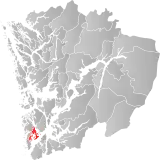Moster Municipality
Moster herad | |
|---|---|
 Siggjo and Bømla bridge | |
 Hordaland within Norway | |
 Moster within Hordaland | |
| Coordinates: 59°41′57″N 05°23′08″E / 59.69917°N 5.38556°E | |
| Country | Norway |
| County | Hordaland |
| District | Sunnhordland |
| Established | 1 July 1916 |
| • Preceded by | Finnås Municipality |
| Disestablished | 1 Jan 1963 |
| • Succeeded by | Bømlo Municipality |
| Administrative centre | Mosterhamn |
| Area (upon dissolution) | |
| • Total | 66 km2 (25 sq mi) |
| Population (1962) | |
| • Total | 1,841 |
| • Density | 28/km2 (72/sq mi) |
| Demonym | Mostring[1] |
| Time zone | UTC+01:00 (CET) |
| • Summer (DST) | UTC+02:00 (CEST) |
| ISO 3166 code | NO-1218[2] |
Moster is a former municipality in the old Hordaland county, Norway. The municipality existed from 1916 until 1963, when it was merged into the new, larger municipality of Bømlo. The administrative centre of the municipality was the village of Mosterhamn, where the Old Moster Church is located (the oldest surviving stone church in Norway). The 66-square-kilometre (25 sq mi) municipality encompassed the southeastern part of the island of Bømlo and the island of Moster as well as many surrounding islets.[3]
History
The municipality of Moster was established on 1 July 1916 when the old municipality of Finnås was split into the three new municipalities: Moster (population: 1,316), Bømlo (population: 1,217), and Bremnes (population: 3,411). During the 1960s, there were many municipal mergers across Norway due to the work of the Schei Committee. On 1 January 1963, the three municipalities of Moster (population: 1,834), Bømlo (population: 1,463), and Bremnes (population: 4,829) were merged into a new, larger Bømlo Municipality.[4]
Name
The municipality (originally the parish) is named after the island of Moster (Old Norse: Mostr) since the first Moster Church was built there. The meaning of the first element is uncertain. It may come from the word mosi which means "mossy swamp", likely because the island is marshy. It could also come from the word mostr which means "pleased" or "large amount", possibly referring to the fact that the island is very hilly. Another possibility is that it comes from the word mǫn which means "mane".[5]
Government
During its existence, this municipality was governed by a municipal council of directly elected representatives. The mayor was indirectly elected by a vote of the municipal council.[6]
Municipal council
The municipal council (Heradsstyre) of Moster was made up of 17 representatives that were elected to four year terms. The party breakdown of the final municipal council was as follows:
| Party name (in Nynorsk) | Number of representatives | |
|---|---|---|
| Conservative Party (Høgre) | 2 | |
| List of workers, fishermen, and small farmholders (Arbeidarar, fiskarar, småbrukarar liste) | 2 | |
| Local List(s) (Lokale lister) | 13 | |
| Total number of members: | 17 | |
| Party name (in Nynorsk) | Number of representatives | |
|---|---|---|
| Labour Party (Arbeidarpartiet) | 2 | |
| Local List(s) (Lokale lister) | 15 | |
| Total number of members: | 17 | |
| Party name (in Nynorsk) | Number of representatives | |
|---|---|---|
| Local List(s) (Lokale lister) | 16 | |
| Total number of members: | 16 | |
| Party name (in Nynorsk) | Number of representatives | |
|---|---|---|
| Labour Party (Arbeidarpartiet) | 3 | |
| List of workers, fishermen, and small farmholders (Arbeidarar, fiskarar, småbrukarar liste) | 1 | |
| Joint List(s) of Non-Socialist Parties (Borgarlege Felleslister) | 2 | |
| Local List(s) (Lokale lister) | 10 | |
| Total number of members: | 16 | |
| Party name (in Nynorsk) | Number of representatives | |
|---|---|---|
| List of workers, fishermen, and small farmholders (Arbeidarar, fiskarar, småbrukarar liste) | 4 | |
| Local List(s) (Lokale lister) | 12 | |
| Total number of members: | 16 | |
| Party name (in Nynorsk) | Number of representatives | |
|---|---|---|
| Labour Party (Arbeidarpartiet) | 2 | |
| Local List(s) (Lokale lister) | 14 | |
| Total number of members: | 16 | |
| Note: Due to the German occupation of Norway during World War II, no elections were held for new municipal councils until after the war ended in 1945. | ||
See also
References
- ↑ "Navn på steder og personer: Innbyggjarnamn" (in Norwegian). Språkrådet.
- ↑ Bolstad, Erik; Thorsnæs, Geir, eds. (26 January 2023). "Kommunenummer". Store norske leksikon (in Norwegian). Kunnskapsforlaget.
- ↑ Store norske leksikon. "Moster – kommune" (in Norwegian). Retrieved 16 February 2015.
- ↑ Jukvam, Dag (1999). Historisk oversikt over endringer i kommune- og fylkesinndelingen (PDF) (in Norwegian). Statistisk sentralbyrå. ISBN 9788253746845.
- ↑ Rygh, Oluf (1910). Norske gaardnavne: Søndre Bergenhus amt (in Norwegian) (11 ed.). Kristiania, Norge: W. C. Fabritius & sønners bogtrikkeri. pp. 120–121.
- ↑ Hansen, Tore; Vabo, Signy Irene, eds. (20 September 2022). "kommunestyre". Store norske leksikon (in Norwegian). Kunnskapsforlaget. Retrieved 1 January 2023.
- ↑ "Kommunevalgene og Ordførervalgene 1959" (PDF) (in Norwegian). Oslo: Statistisk sentralbyrå. 1960. Retrieved 16 February 2020.
- ↑ "Kommunevalgene og Ordførervalgene 1955" (PDF) (in Norwegian). Oslo: Statistisk sentralbyrå. 1957. Retrieved 16 February 2020.
- ↑ "Kommunevalgene og Ordførervalgene 1951" (PDF) (in Norwegian). Oslo: Statistisk sentralbyrå. 1952. Retrieved 16 February 2020.
- ↑ "Kommunevalgene og Ordførervalgene 1947" (PDF) (in Norwegian). Oslo: Statistisk sentralbyrå. 1948. Retrieved 16 February 2020.
- ↑ "Kommunevalgene og Ordførervalgene 1945" (PDF) (in Norwegian). Oslo: Statistisk sentralbyrå. 1947. Retrieved 16 February 2020.
- ↑ "Kommunevalgene og Ordførervalgene 1937" (PDF) (in Norwegian). Oslo: Statistisk sentralbyrå. 1938. Retrieved 16 May 2020.
